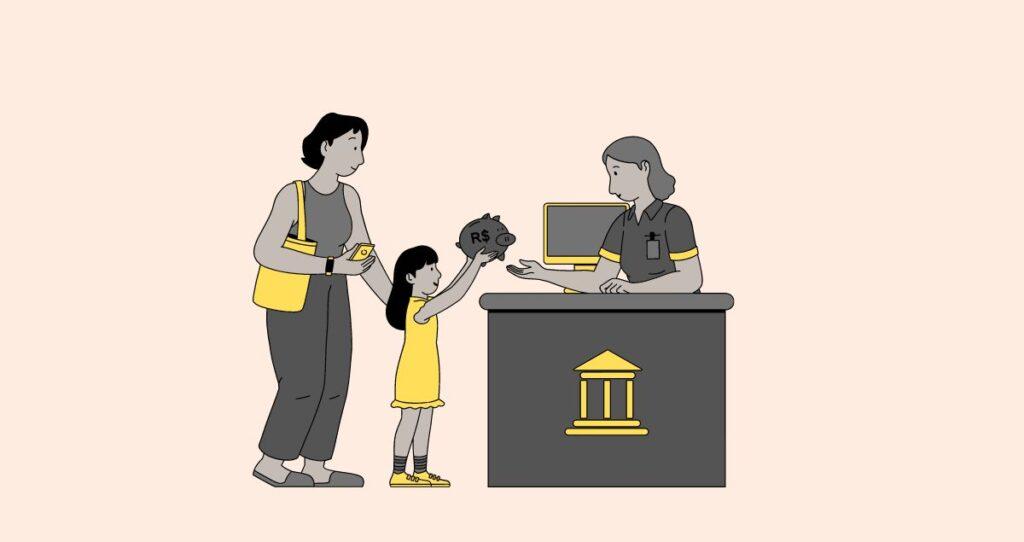While having a savings account allows you to save for emergencies and earn a small interest on your funds; there are times when closing your savings account is the best financial choice you can make. For example, if you experience a life event, want to consolidate your savings accounts, want higher rates, or are not satisfied with your current bank’s terms, it might be wise to close your savings account.
The process of closing your savings account is relatively simple. If you want to close your savings account, call your banks, or credit union and explain that you intend to close the account. You can also visit a nearby physical branch or close your savings account online.
Before closing your account, however, make sure that all automatic payments linked to your savings account and deposits are redirected to another account to avoid financial setbacks down the road. You should also settle any outstanding balances, fees, or overdrafts and make sure there are no pending checks or transactions on the account.
If you are ready to close your savings account and restructure your savings strategies, here is a step-by-step on how to do it.
Reasons to close a savings account
As you prepare to close your savings account, it’s essential to have clarity on your reasons behind this decision. There are various circumstances that might lead you to this path, and understanding your motivations can help you make informed choices about your financial future.
Here are the reasons you need to close your savings account
1. You need better rates
Even if savings accounts are known for their meager annual percentage rates(APYs), not all savings accounts are created equal. Some savings accounts come with higher rates especially high-yield savings accounts which are normally offered by online banks and credit unions. If your savings account has been earning you a small return, you can close it and reinvest your money in a high-yield account.
You can also open a CD account which allows you to earn a much higher rate than traditional savings accounts. Before you open a CD, however, keep in mind that you will not have access to your funds until your CD matures. Withdrawing funds from your CD account before maturity will trigger an early CD withdrawal penalty which is usually a number of months or days of interest unless you have a liquid CD. Here are different types of CDs and how to pick the right one.
2. You need to consolidate your savings
Maybe you have multiple savings accounts spread across different banks, and managing them has become cumbersome. By closing some of your savings accounts and consolidating them into one, you can simplify your financial life and have a clearer overview of your savings.
3. You experienced a life event
Life events can also prompt the need to close a savings account. Perhaps you’re moving to a different city or country where your current bank doesn’t have a presence. In such cases, it’s practical to close your existing saving account and open a new one that suits your new circumstances. Additionally, if you’re getting married or divorced, merging or separating your finances may require closing and opening accounts accordingly.
4. The company’s policies no longer align with your saving goals
Sometimes, financial institutions change their policies or services which might affect your financial goals and needs. For example, if your current bank begins charging excessive fees or eliminates benefits that were important to you, it might be time to close a savings account and move your savings elsewhere.
5. You no longer need the account
If your existing savings account is no longer needed, you might have to close the account and move your funds elsewhere.
6. Your bank, credit union, or financial institution is not good
Is your current bank treating you badly? If you feel dissatisfied or unhappy with your current savings account, it’s perfectly valid to seek a change. Maybe the customer service hasn’t met your expectations, or you’ve encountered other issues that have eroded your confidence in the bank. In such cases, closing your account allows you to find a financial institution that values and prioritizes your needs.
7. You need access to a reliable mobile app
Due to the rise of mobile services, most banks and credit unions have created mobile apps that make your banking experience smooth and easy. For example, many banks allow you to conduct almost all banking activities such as transfers, depositing checks, etc, from your mobile phone. If your bank does not have a reliable mobile app that makes your banking experience easy, it might be time to close your savings account and open an account with another bank.
Steps to close a savings account
If you are ready to make a change in your savings practices and there is no turning back, the following is a step-by-step guide to closing your savings account.
Step 1: Assess your financial situation
Before you jump into the process of closing your savings account, take a moment to evaluate your overall financial situation. Delving into this step will help you make an informed decision about how to use your funds and what to look for in the next bank.
Are you dissatisfied with your current bank’s offerings? Are there better options out there that align with your financial goals and values? Take the time to reflect on what you truly need and desire from a financial institution.
Think about the key factors that made you want to close the account. Do you prioritize higher interest rates, lower fees, or more convenient banking options? By carefully evaluating your needs and desires, you can confidently move forward with your decision to close your savings account and find an alternative bank that meets your goals.
Step 2: Research and choose a new bank or financial institution
Researching and choosing a new bank or financial institution is a crucial step in the process of closing your savings account. Just as you carefully considered your financial situation before deciding to close your savings account, it’s important to dedicate time to finding the right institution that can meet your needs and help you achieve your financial goals.
Here are steps to finding the best bank for your next savings account
- Start by identifying your specific requirements and preferences. Do you value a brick-and-mortar bank with physical branches, or are you comfortable with an online-only bank? Are you looking for a bank that offers a wide range of financial products and services, or do you prefer a more specialized institution? Take into account factors such as account fees, interest rates, customer service, and any additional features or perks that are important to you.
- Conduct thorough research to gather information about potential banks. Online resources like comparison websites, customer reviews, and financial forums can provide valuable insights and experiences from other customers. Pay attention to the reputation and stability of the institutions you consider, as well as any potential red flags or recurring issues reported by customers.
- Visit the banks’ branches and websites. Once you have narrowed down your options, take the time to visit the websites or physical branches of the banks you are considering. Familiarize yourself with their account options, terms, and conditions. Look for any special promotions or introductory offers that may be available.
- Pick the right bank that fits your financial goals. After visiting different banks, credit unions, and online banks, choose one that best fits your financial needs and saving goals.
Step 3: Redirect automatic payments and direct deposits from the account
Before closing your savings account it is essential to redirect any payment activities and deposits linked to your account. For example, if your savings account is used to automatically pay your bills or as a direct deposit for your paycheck, you must cancel these automatic payments and link them to another account before closing your current savings account to avoid missing a payment or a paycheck.
Step 4: Transfer or withdraw funds from your savings account
Before closing a savings account, you first need to make sure the account is empty by withdrawing all funds or transferring them to a different bank.
When it comes to transferring or withdrawing funds from your savings account, it’s essential to be aware of the specific processes and requirements of your current bank and your new bank. Additionally, you will need to verify your identity on both accounts.
Here is the information you might need to get ready to transfer all your money from a savings account.
- Account number
- Personal identification, such as photo ID when visiting a branch,
- Social security number
- Proof of your new account with the receiving institution.
If you are transferring your funds online, your bank might only need to know the account information where the money is going. Again, the process differs from one institution to another.
Step 5: Notify your current bank or financial institution
Closing a savings account involves more than simply withdrawing funds or transferring them to a new account. It’s important to formally notify your current bank or financial institution about your decision. This step ensures that your request is processed promptly and that any necessary paperwork is completed correctly.
So, reach out to your bank through their preferred communication channel. This could be by phone, email, or visiting a branch in person. Be sure to have your account details on hand, including the account number, your identification information, and any required documents or forms.
When contacting your financial institution, clearly communicate your intent to close the savings account. Explain your reasons and outline your plans for the funds, whether it’s transferring them to a new account or withdrawing them completely. This will help the bank understand your needs and provide any necessary guidance or assistance.
During this conversation, it’s also a good opportunity to inquire about any potential fees or restrictions associated with closing the account. Some banks may charge an account closure fee, especially if you’re closing the account before a certain timeframe, so it’s important to be aware of any potential costs. Similarly, certain types of accounts may have withdrawal restrictions or penalties, so it’s advisable to discuss these with your bank representative.
Step 6: Complete the account closure process
Once you’ve provided all the required information and completed any necessary paperwork, your bank or financial institution will process your account closure request. If After your account is closed, you will receive the remaining balance through a check or by transferring it to your new account.
Step 7: Update your financial records and continue saving
After closing your savings account, you will need to update your financial records. This step allows you to maintain an accurate and up-to-date picture of your overall financial situation. Take the time to review your statements, balances, and any automatic transfers or payments linked to your savings account. Ensure that you make the necessary adjustments to reflect your new account status. This will help you avoid any confusion or potential issues down the line.
Is there a penalty for closing a savings account?
Most banks, credit unions, and other financial institutions do not charge a penalty for closing a savings account. However, some institutions may charge a fee if you close your savings account within a certain timeframe, which is known as an early closure fee. According to Bankrate, you might be charged a fee to close a saving account if you decide to close it within 90 to 180 days of opening it.
This fee is designed to discourage customers from frequently opening and closing accounts, as it can disrupt bank operations. The fee also differs from one institution to another, but it is usually between $10 to $50. To know if you will be paying a fee for closing your savings account and how much it will cost you, contact your institution.
Can I close a savings account online?
Many banks offer the option to close a savings account through their online banking platforms.
Closing a savings account online can be a relatively simple and straightforward process. Typically, you’ll need to log into your online banking account and navigate to the account management section. From there, you should be able to find an option to close your savings account.
It’s important to note that the exact steps may vary depending on the bank you’re with. Some banks may require you to fill out an online form, while others may provide a direct option to initiate the closure. In any case, the process should be intuitive and easy to follow.
While closing a savings account online can offer convenience, it’s worth considering a few factors before going ahead with the process. Make sure to review any applicable fees or penalties for closing the account early. As we discussed earlier, some banks may charge a fee for closing a savings account before a certain period of time.
Additionally, take into account any pending transactions or automatic transfers linked to your savings account. It’s important to ensure that you have redirected these transactions to another account before closing your savings account. This will help avoid any disruptions or missed payments.
Does closing a savings account hurt credit?
Closing a savings account typically does not have a direct impact on your credit score. This is because your credit score is only based on how you manage debt and your credit accounts. Unlike credit cards and loans, savings accounts are not considered lines of credit. So, the closure of your savings account doesn’t affect the factors that contribute to your credit score, such as payment history, credit utilization, or the age of your credit. For this reason, closing a savings account will not affect your credit score.
Additionally, your savings account activities including its closure are not reported to credit reporting agencies(Equifax, TransUnion, and Experian). Meaning, they won’t be on your credit report or have an impact on your credit.
How long does it take to close a savings account?
The time it takes to close a savings account can vary depending on the bank and the specific circumstances surrounding the closure.
In general, closing a savings account can be a relatively quick process. If you visit a branch in person, the account closure can often be completed within the same day. This is especially true if you have all the necessary documents and identification with you. The bank will likely require you to fill out a form requesting the closure and may ask you for a valid reason for closing the account.
However, if you prefer to close your savings account remotely or through online banking, the process may take slightly longer. Some banks may require you to submit a closure request through their secure online portal. In these cases, it may take a few business days for the bank to process your request and finalize the closure.
It’s worth noting that some banks may have specific policies or procedures in place for closing an account, which can also affect the timeline. For example, if you have a joint savings account, the bank may require both account holders to be present or provide written consent for the closure. This can add an additional layer of complexity and potentially prolong the closure process.
Can a bank refuse to close your account?
Banks are legally required to honor your request to close a savings account, according to the Consumer Financial Protection Bureau(CFPB). After all, it is your money and you have the right to decide how to manage it. However, there are some instances where a bank may refuse to close your account.
One common reason for a bank to refuse an account closure request is if there are outstanding fees or charges associated with the account. If you have unpaid fees, overdrafts, or other outstanding balances, the bank may require you to settle those before closing the account. This is to ensure that all financial obligations are met and to protect their own interests.
Additionally, if you have a joint savings account with another individual, both account holders may need to provide consent to close the account. Banks typically require all account holders to agree on the closure, as it affects both parties involved.
Another reason a bank may refuse to close your account is if there are any legal restrictions or court orders in place. For example, if your account is involved in an ongoing legal dispute or if a court has issued an order freezing your assets, the bank may be obligated to keep the account open until the matter is resolved.
To avoid any potential issues or delays in closing your savings account, ensure that all outstanding fees and charges are settled and that any joint account holders provide their consent if necessary. If you are facing any legal restrictions or court orders, it may be advisable to consult with legal counsel to understand the proper procedure for closing your account.
How much does it cost to close a bank account?
Generally speaking, it does not cost money to close a savings account. However, some banks may charge a fee for closing an account short after opening it, while others may not have any specific charges. The account closure fees typically range between $10 to $50. It is crucial to review the terms and conditions of your account agreement or reach out to your bank’s customer service to determine if there are any costs involved in closing your account.
The cost associated with closing a bank account can vary depending on the financial institution. Some banks may charge a fee for closing an account, while others may not have charges. It is crucial to review the terms and conditions of your account agreement or reach out to your bank’s customer service to determine if there are any costs involved in closing your savings account.
More saving tips
Closing a CD early: When does it make sense?
5 reasons why you can’t save money every month
5 types of savings accounts to help you manage your finances









